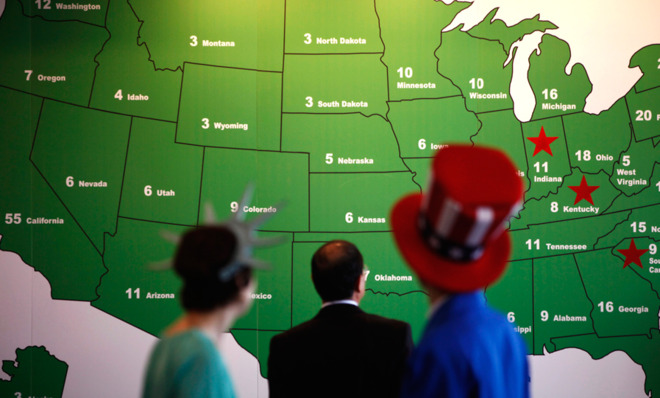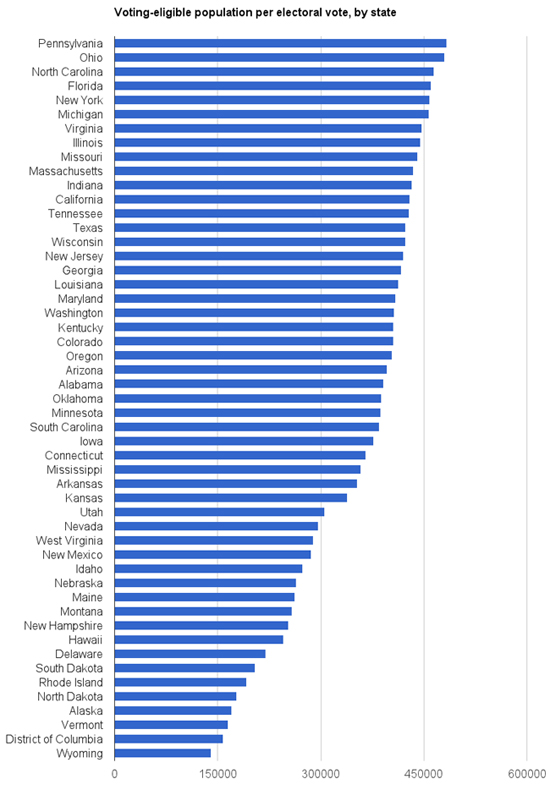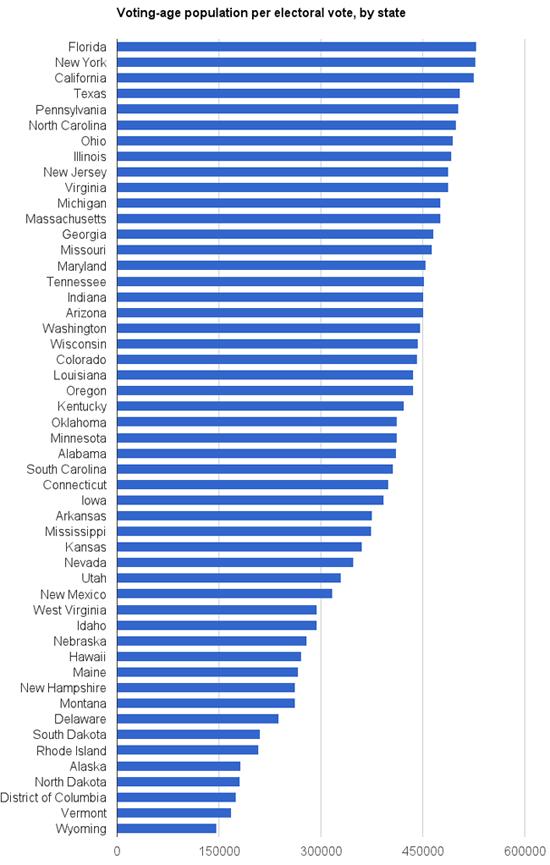Which states get screwed worst by the Electoral College?
The answer might surprise you


New York state recently signed on to the National Popular Vote movement, an interstate compact designed to do an end run around the Electoral College, which as everybody knows is an outdated institution that at its worst can throw the presidency to the guy who failed to win the popular vote. Hendrik Hertzberg explains:
Here's how it works: Suppose you could get a bunch of states to pledge that once there are enough of them to possess at least 270 electoral votes — a majority of the Electoral College — they will thenceforth cast all their electoral votes for whatever candidate gets the most popular votes in the entire country. As soon as that happens, presto change-o: the next time you go to the polls, you'll be voting in a true national election. No more ten or so battleground states, no more forty or so spectator states, just the United States — all of them, and all of the voters who live in them. [The New Yorker]
This got me wondering: Which states get the worst deal from the Electoral College, technically speaking? Everyone knows that the good people of Wyoming make out like bandits, but which voters are least represented in a presidential contest?
I assumed that since the least populated states are the most preposterously over-represented, the largest states, like California and Texas, would suffer the most when compared against the ideal of a "one-person, one vote" standard.
The Week
Escape your echo chamber. Get the facts behind the news, plus analysis from multiple perspectives.

Sign up for The Week's Free Newsletters
From our morning news briefing to a weekly Good News Newsletter, get the best of The Week delivered directly to your inbox.
From our morning news briefing to a weekly Good News Newsletter, get the best of The Week delivered directly to your inbox.
Nope! Taking voting-eligible population data from here, I divided each state's voting population by its electoral votes. This gives us the number of eligible voters it takes to obtain a single electoral vote. And here's the chart:

Wait, Pennsylvania is number one? And California isn't even in the top 10? What is going on here? Just out of curiosity, I plugged in raw voting-age population instead (that is, not excluding people who are ineligible to vote) and produced another chart:

That's more like it. It turns out that many states have huge populations of people who are ineligible to vote. California and Texas, for example, have 5.1 million and 2.6 million non-citizens, respectively, which cuts down their voting-eligible populations significantly. Florida, meanwhile, has slashed its voting population by over 10 percent through the disenfranchisement of felons. (Ironically, this makes its position in the Electoral College look "fairer," since by raw population the Sunshine State comes out the worst.)
In any case, as Hertzberg makes clear, every state that doesn't have a delicate ideological balance is actually getting screwed by the Electoral College — that is to say, practically all of them. However, it is still striking to note that the vote of a Wyoming resident is weighted nearly three and half times more than that of a Pennsylvania resident. Not to mention that it's theoretically possible to win the presidency with nearly 80 percent of the population voting against you.
A free daily email with the biggest news stories of the day – and the best features from TheWeek.com
But with New York on board, the National Popular Vote movement is now over 60 percent of the way to bringing us a real democratic election. Whaddya say, Pennsylvania? Y'all are getting shafted here.
Ryan Cooper is a national correspondent at TheWeek.com. His work has appeared in the Washington Monthly, The New Republic, and the Washington Post.
-
 Bari Weiss’ ‘60 Minutes’ scandal is about more than one report
Bari Weiss’ ‘60 Minutes’ scandal is about more than one reportIN THE SPOTLIGHT By blocking an approved segment on a controversial prison holding US deportees in El Salvador, the editor-in-chief of CBS News has become the main story
-
 Has Zohran Mamdani shown the Democrats how to win again?
Has Zohran Mamdani shown the Democrats how to win again?Today’s Big Question New York City mayoral election touted as victory for left-wing populists but moderate centrist wins elsewhere present more complex path for Democratic Party
-
 Millions turn out for anti-Trump ‘No Kings’ rallies
Millions turn out for anti-Trump ‘No Kings’ ralliesSpeed Read An estimated 7 million people participated, 2 million more than at the first ‘No Kings’ protest in June
-
 Ghislaine Maxwell: angling for a Trump pardon
Ghislaine Maxwell: angling for a Trump pardonTalking Point Convicted sex trafficker's testimony could shed new light on president's links to Jeffrey Epstein
-
 The last words and final moments of 40 presidents
The last words and final moments of 40 presidentsThe Explainer Some are eloquent quotes worthy of the holders of the highest office in the nation, and others... aren't
-
 The JFK files: the truth at last?
The JFK files: the truth at last?In The Spotlight More than 64,000 previously classified documents relating the 1963 assassination of John F. Kennedy have been released by the Trump administration
-
 'Seriously, not literally': how should the world take Donald Trump?
'Seriously, not literally': how should the world take Donald Trump?Today's big question White House rhetoric and reality look likely to become increasingly blurred
-
 Will Trump's 'madman' strategy pay off?
Will Trump's 'madman' strategy pay off?Today's Big Question Incoming US president likes to seem unpredictable but, this time round, world leaders could be wise to his playbook



